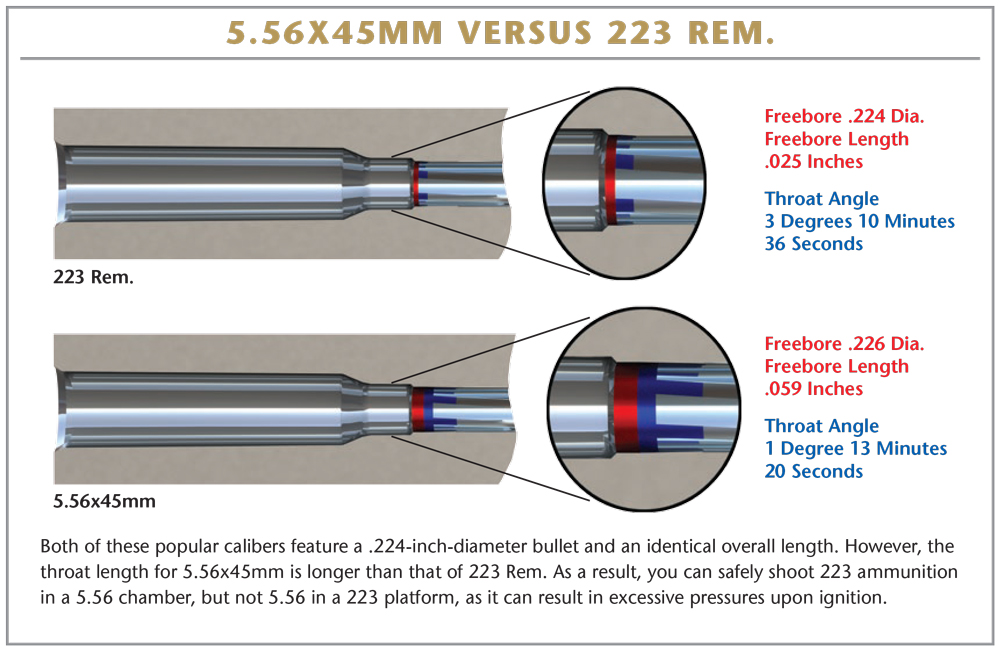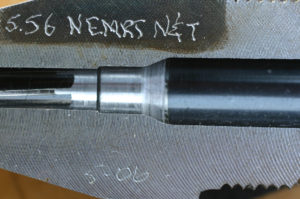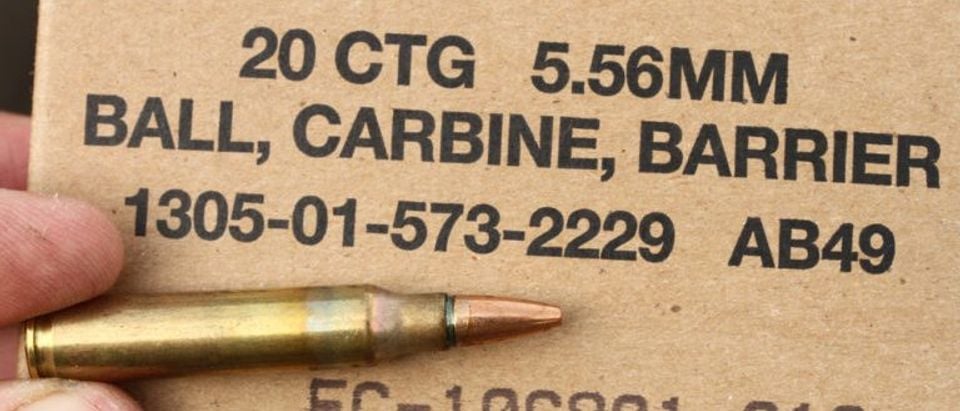By Patrick Sweeney, Gun Digest
The rifle and cartridge designers did that deliberately to allow for a hotter load and higher velocities because the longer leade allows for more run-up to the engraving.
Some 5.56 chamber drawings show a larger diameter in the leade proper than is in a .223. This larger diameter is there less for pressure than function. In a really harsh environment, a scosh more room in the leade can keep a rifle running, where one with a tight leade (not a short leade, the two differ) would choke. The government is more interested in a rifle that keeps working, even if it means they have to accept a 3 MOA accuracy level, instead of a 2 MOA potential.
When you put 5.56×45 ammunition, meant to utilize a longer leade, into a chamber cut for the .223 with its shorter leade, you get a pressure spike. How much? To find out, I sent some 5.56 ammo off to a test lab. No big secret, the ammo was a batch of Federal XM-193, 55-grain FMJ brown box. I had them test it for pressure in two laboratory barrels — one chambered in 5.56, and the other in .223.
In the 5.56 test barrel, the XM-193 produced 48,000 PSI. A little on the low side, but since it delivered the expected velocity, why should Federal have loaded it any hotter? In the .223 barrel, the same ammo produced 62,000 PSI. That’s a big spike. Now, someone is going to say that it is no big deal. They’ll assert your AR can shrug off a diet of 62,000 PSI ammo, after all, it isn’t that much more than the 55,000 PSI the spec calls for, and hardly anything over the NATO pressure.
Remember my advice about people you can ignore? This is one example. A pressure increase of 29 percent is not “nothing.” And what if the original pressure had not been 48,000, but something more like what we’d expect, say 52,000? Then a straight 29 percent increase (and this is not usually a linear response) would make it 67,000 PSI. I have talked to other gunsmiths and AR-savvy people who have done the same thing and their experience of a 52,000 original round has been more along the lines of 72,000 PSI.

–
A 29 percent increase is pretty close to the increase in pressure that a proof round produces. How do you know if your barrel is .223 or 5.56? Measure it with a gauge produced by Ned Christiansen. If you have a .223 instead of the 5.56 you thought you had, ream it with a 5.56 reamer, also from Christensen.
The gauge has a short section that replicates the neck and leade of a 5.56 chamber drawing. Start by dropping the gauge into a recently cleaned chamber. If the leade has been cut to .223 dimensions, it wedges in place. However, if by turning the receiver upside down, the gauge falls out, you have a 5.56 leade.

Use a felt-tip marker to darken the gauge to see exactly where it is binding. But while that can be fun, it does not correct a short leade.
And a reminder, this has nothing to do with headspace.
The reamer is designed so that it will cut the leade and only the leade. It is meant for carbon steel, stainless steel and chrome-plated bores. It will not cut a barrel treated via the Melonite process, and attempting that will only dull the reamer. You can spend all day using it in the appropriate barrels, and not change the headspace at all. The process goes like this. Having cleaned the chamber, apply a bit of lube to the cutting flutes of the reamer. Insert the reamer and turn clockwise as it bottoms out. You’ll feel it cutting. Once you feel that it is no longer cutting, keep on rotating it in the correct direction as you pull it out.
Do not rotate backward. Do not simply drop it in. Keep rotating clockwise as you lift it out.
Brush the chips off the reamer, and put it away. Swab the chamber, then push a patch down the bore to get all the chips and cutting oil out of the bore. Done.
Thanks to Gun Digest for this post. Click here to visit GunDigest.com.
If you just read this article then likely you are an AR person. Click here to check out Gunsmithing the AR-15: The Bench Manual By Patrick Sweeney.


